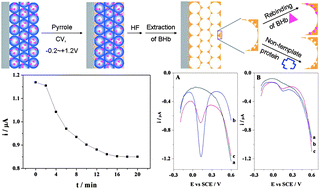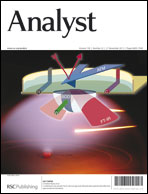Surface molecularly imprinted polymers-based electrochemical sensor for bovine hemoglobin recognition†
Abstract
A novel electrochemical sensor for bovine hemoglobin (BHb) recognition and detection was prepared by a surface molecularly imprinted technique. Aldehyde group-functionalized silica microspheres were modified on an Au electrode surface, and these were subsequently covalently bound with the template molecule, BHb, through imine bonds. Electropolymerization was performed to deposit polypyrrole onto the above modified electrode surface. A three-dimensional macroporous structural sensor was obtained after etching of silica and the extraction of BHb. Differential pulse voltammetry (DPV) and electrochemical impedance spectroscopy (EIS) were employed to characterize the fabrication process of the sensor using [Fe(CN)6]3−/[Fe(CN)6]4− as an electroactive probe. Since all imprinted cavities were situated at the surface of the polymers, the prepared sensor exhibited considerably fast binding kinetics. Compared to other non-template proteins, the sensor showed an excellent recognition capacity for BHb. Moreover, the prepared sensor also exhibited a dependent relationship between the concentration of BHb and the peak current of [Fe(CN)6]3−/[Fe(CN)6]4−.


 Please wait while we load your content...
Please wait while we load your content...